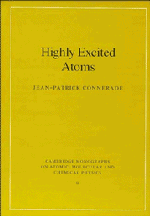Book contents
- Frontmatter
- Contents
- Preface
- 1 Closed shells, sphericity, stability and ‘magic numbers’
- 2 Rydberg states
- 3 Quantum defect theory for bound states
- 4 Atomic f values
- 5 Centrifugal barrier effects
- 6 Autoionisation
- 7 Inner-shell and double-excitation spectra
- 8 K-matrix theory of autoionising resonances
- 9 Atoms in strong laser fields
- 10 Statistical methods and ‘quantum chaology’
- 11 Atomic effects in solids
- 12 Atomic clusters
- References
- Index
9 - Atoms in strong laser fields
Published online by Cambridge University Press: 19 September 2009
- Frontmatter
- Contents
- Preface
- 1 Closed shells, sphericity, stability and ‘magic numbers’
- 2 Rydberg states
- 3 Quantum defect theory for bound states
- 4 Atomic f values
- 5 Centrifugal barrier effects
- 6 Autoionisation
- 7 Inner-shell and double-excitation spectra
- 8 K-matrix theory of autoionising resonances
- 9 Atoms in strong laser fields
- 10 Statistical methods and ‘quantum chaology’
- 11 Atomic effects in solids
- 12 Atomic clusters
- References
- Index
Summary
Multiphoton spectroscopy
The subject of multiphoton excitation spectroscopy began in 1931 when Göppert-Mayer [450] wrote a theoretical paper in which she calculated the transition rate for an atom in the presence of two photons rather than just one. At the time, the process seemed rather exotic, and it was reassuring that the calculated rate was so low as to guarantee that it could not readily be observed in the laboratory with conventional sources. This conclusion was reassuring because it implies that a simple perturbative theory (one photon per transition is the weak-field limit) is adequate for most purposes.
The subject came to life with the advent of lasers, when it became easy to create intense beams of light. Since the probability of excitation by two photons grows as the square of the photon density, whereas the probability of single-photon excitation grows only linearly with photon density, two-photon transitions gain in relative strength with increasing intensity despite the small value of the rate coefficient.
The development of multiphoton spectroscopy has followed that of lasers: as the available power has increased, so has the number of photons involved in individual transitions. More significantly, it has become apparent that the physics of the interaction between radiation and matter is not the same at high laser powers as under weak illumination, i.e. that there is a qualitative change which sets in at strong laser fields. This is normally expressed by saying that perturbative approximations break down.
- Type
- Chapter
- Information
- Highly Excited Atoms , pp. 325 - 362Publisher: Cambridge University PressPrint publication year: 1998



